Workplace Communication Styles
The ability to communicate effectively in the workplace is an essential life skill and everyone has their own style that they naturally adapt and develop to suit the different environments they operate in. Our need to educate, inform, persuade, or entertain drives our communications.
Each person's communication style is a unique combination of their own innate skills and those learnt both formally and through experience. What makes some people better than others at communicating is their ability to adapt their style to suit the message, environment, and exchange.
 |
Whilst individuals may favor a particular way of communicating, they can alter their behavior to other communication styles if necessary to suit a particular situation. This flexibility helps them to come across as knowledgeable, confident, and empathetic.
There are four basic styles of communication, with a fifth being a combination of two or more of the four. Each of the four styles describes how you act in the majority of your communications. For example, do you usually:
• Take an active role in the communications?
• Connect and empathize with others?
• Take time to think and respond?
• Follow a logical path?
Or do you find that you usually use a combination of the four?
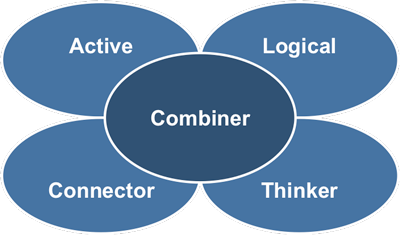 |
To discover which is your favored way to communicate read the following statements objectively and honestly. Highlight those that you feel best describes how you like to behave when communicating with others.
Do not try to relate them to any situation, just consider if it describes your natural feelings when communicating. The more honest you are in your selections the better you will know how you really communicate.
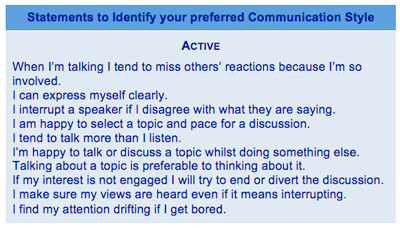 |
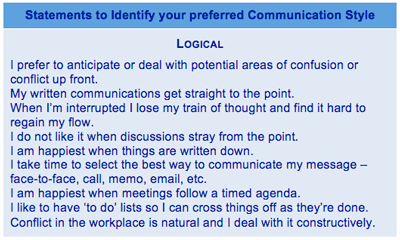 |
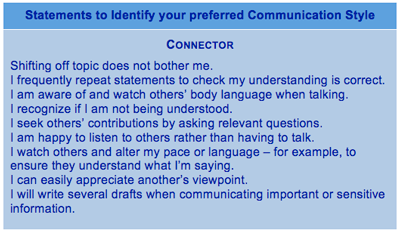 |
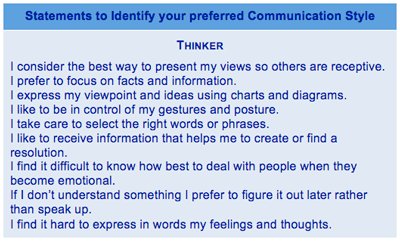 |
 |
Once you have read through all the statements have a look at the number of highlights you have in each section. If one section dominates the highlights then this is your natural style of communication and will be how you conduct the majority of your exchanges.
If there are a similar number of highlights in each section then you are a 'Combiner' - that is, an individual who uses a variety of communication styles, happily changing between them to achieve their objective.
Once you have determined your favored style of communication you must ask yourself:
Does your communication behavior match that of your organization's style of communication? If not, what can you do to make them more compatible?
Is this the most effective style of communication for your role? If not, which style best suits your role? Can you learn to adjust your communications style?
Are your current communication skills likely to enhance your career? If not, how can you develop them?
Armed with the answers to these questions you will be able to determine how much correlation your current communication skills have with your role and organization. This will help you identify the best ways to develop these gaps in your communication skills to suit any situation you encounter.
The more you are able to adapt your style to suit the situation and environment the more effective your communications will be. This is the skill that 'combiner' communicators display in all their exchanges.
One of the most effective ways to develop and enhance your communication skills is to actively seek new opportunities that test your ability to adapt and push the boundaries of your usual style. The more you communicate in a wide variety of situations the greater your ability to deal with any communications environments regardless of the context or circumstances.
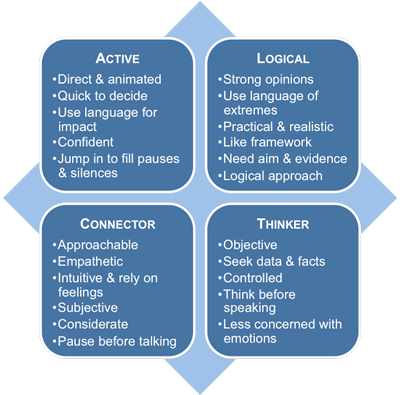 |
Each of the communication styles has its own characteristics as shown in the diagram. It is useful to be aware of these for two important reasons. Firstly, it helps you to appreciate how others might perceive you in an exchange. Secondly, you will be able to identify the same attributes in those you communicate with. This Communication Style Checklist will help you to identify your own preferred communication style so that you come across with confidence and empathy.
You may also be interested in:
Effective Communication in the Workplace | Recognizing Workplace Communication Styles | Perceptual Preferences | Attitudes to Communications | Communication Research | Using the RESULT Principle | Barriers to Communication.



